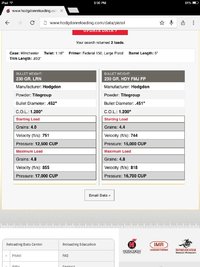Need to be very careful. My Sierra book has loading data for 45acp revolver and semi-auto.
I didn't realize there was such a thing as a 45acp revolver so I loaded 6.1 grains tight group which is appropriate for 230gr fmj.
Luckily a friend caught that and I pulled them all out and reloaded with 4.6 gr tight group 1.2" OAL
I do have a question about the crimp, since .45acp headspace at the case mouth, I am very careful not to over crimp. Case mouth spec is .473 and I'm running .469 and still seeing a half hair width gap between the case and bullet. Is this normal? I was thinking it might be because the bullet is set so far in. 1.2 oal is the spec on hodgedon's website. I know some factory loads won't go into my my fnp45's magazine.
Will .469 be far too under the .473 spec? Is my im trying to avoid feed and headspace issues. I will not be able to test these rounds out until Saturday.
Sent from my iPhone using Tapatalk
I didn't realize there was such a thing as a 45acp revolver so I loaded 6.1 grains tight group which is appropriate for 230gr fmj.
Luckily a friend caught that and I pulled them all out and reloaded with 4.6 gr tight group 1.2" OAL
I do have a question about the crimp, since .45acp headspace at the case mouth, I am very careful not to over crimp. Case mouth spec is .473 and I'm running .469 and still seeing a half hair width gap between the case and bullet. Is this normal? I was thinking it might be because the bullet is set so far in. 1.2 oal is the spec on hodgedon's website. I know some factory loads won't go into my my fnp45's magazine.
Will .469 be far too under the .473 spec? Is my im trying to avoid feed and headspace issues. I will not be able to test these rounds out until Saturday.
Sent from my iPhone using Tapatalk



